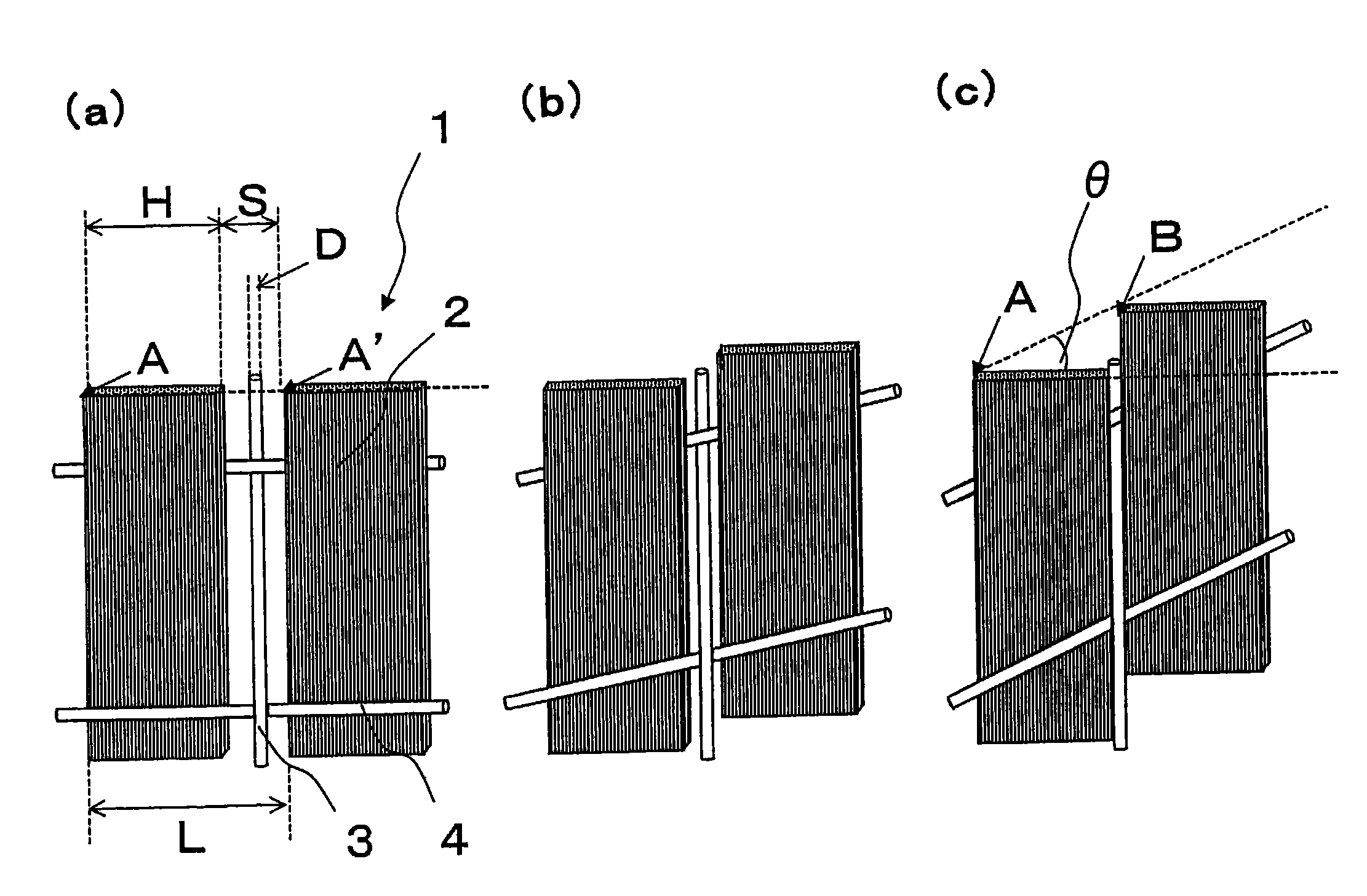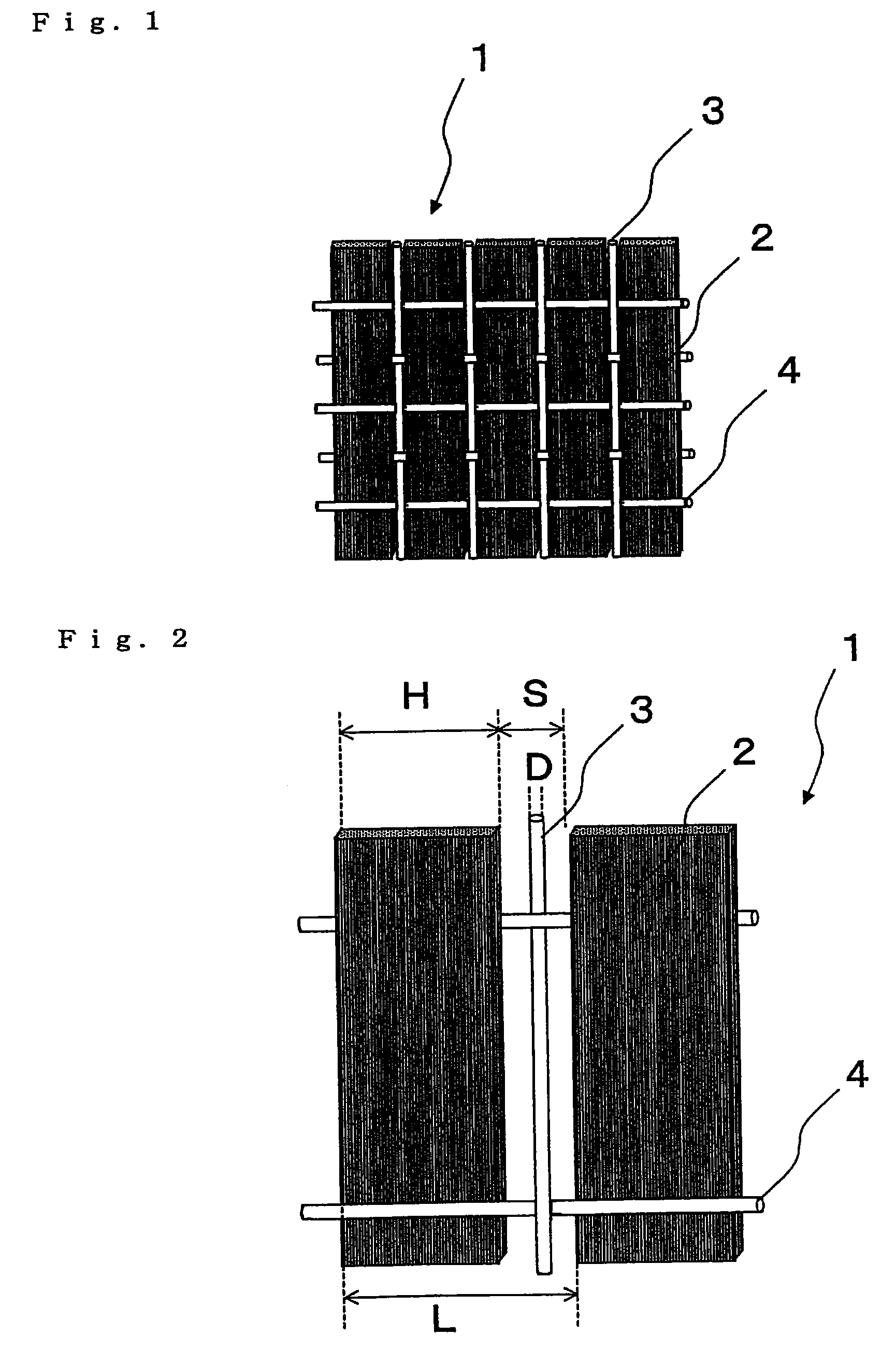Reinforcing fiber base material for preforms, process for the production of laminates thereof, and so on
a technology of reinforced fiber and preforms, applied in the direction of synthetic resin layered products, chemistry apparatus and processes, transportation and packaging, etc., can solve the problems of high cost of molded parts formed therefrom, low productivity of preforms, and high cost of preforms, and achieve high mechanical properties, high production efficiency, and excellent drapability
- Summary
- Abstract
- Description
- Claims
- Application Information
AI Technical Summary
Benefits of technology
Problems solved by technology
Method used
Image
Examples
example 1
[0276]A unidirectional, non-crimping carbon fiber woven fabric having a carbon fiber weight of 190 g / m2 was produced and used as the unidirectional reinforcing fiber base material. For the reinforcing fiber filaments, essentially untwisted carbon fiber filaments were used as the vertical fibers, the carbon fiber filaments having a filament count of 24,000, a width of 5.4 mm, a tensile strength of 5.8 GPa, a tensile elastic modulus of 290 GPa, and an amount of adhering sizing agent equal to 0.5 wt %. For the vertical auxiliary fibers, 22.5 dtex glass fibers having a coupling agent adhesed thereto and covered with 17 dtex refined nylon 66 covering fibers at 250 twists per meter were used. For the horizontal auxiliary fibers, essentially untwisted, refined, 17 dtex nylon 66 filaments were used. The woven density of the carbon fiber filaments and the vertical auxiliary fibers were both 1.84 strands / cm, the woven density of the horizontal auxiliary fibers was 3 strands / cm, and the length...
example 2
[0281]The laminate obtained in Example 1 was placed in an iron mandrel having a partially spherical shape of curvature 800 mm and a chord having two-dimensional curvature of length 350 mm, and then covered with silicon rubber of thickness 1.5 mm. After sealing the edges of the silicon rubber to the mandrel using sealant, the space formed by the mandrel and the silicon rubber was evacuated with a vacuum pump, and the laminate was pressed and draped form by the mandrel.
[0282]The laminate was then inserted into an oven while still subject to pressure by the mandrel and then heated at a temperature of 80° C. for two hours, thereby causing the sheets of carbon fiber woven fabric base material to bond together. Subsequently, the laminate was removed from the oven and cooled to room temperature, and thus a preform was obtained. After peeling off the silicon rubber from the mandrel, the preform was covered again with a bagging film, and the edges of the bagging film were sealed to the mandr...
example 3
[0284]A preform was produced identically to Example 2, except that the mandrel used was an iron mandrel having a partially spherical shape of curvature 400 mm and a chord having two-dimensional curvature length of 350 mm. Similarly to Example 2, measuring the preform reinforcing fiber volume fraction Vpf of the preform resulted in a preform reinforcing fiber volume fraction Vpf of 52%.
[0285]The obtained preform exhibited no wrinkles over the entire surface thereof, the layers of carbon fiber woven fabric base material were bonded together, and the preform favorably retained the mandrel shape.
PUM
| Property | Measurement | Unit |
|---|---|---|
| glass transition temperature Tg | aaaaa | aaaaa |
| glass transition temperature Tg | aaaaa | aaaaa |
| width | aaaaa | aaaaa |
Abstract
Description
Claims
Application Information
 Login to View More
Login to View More - R&D
- Intellectual Property
- Life Sciences
- Materials
- Tech Scout
- Unparalleled Data Quality
- Higher Quality Content
- 60% Fewer Hallucinations
Browse by: Latest US Patents, China's latest patents, Technical Efficacy Thesaurus, Application Domain, Technology Topic, Popular Technical Reports.
© 2025 PatSnap. All rights reserved.Legal|Privacy policy|Modern Slavery Act Transparency Statement|Sitemap|About US| Contact US: help@patsnap.com



